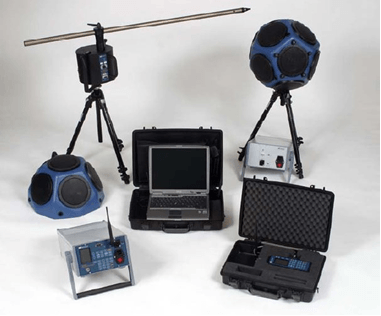The short answer is "yes", the longer answer is "it depends". Factors involved in the decision about sound attenuation tests or acoustical testing are outlined in this article.
More...
What is Soundproofing?
Soundproofing is the ability of a building structure to reduce the transmission of sound between rooms. In this article, we are talking about airborne sound insulation between rooms in a building.
Why Test Soundproofing?
Before you undertake any acoustical testing as it relates to soundproofing, such as a sound attenuation test, you should answer a few basic questions first. By answering these questions upfront, you will save effort, time, and money.
Let’s explore some possible questions and answers about acoustical testing.
What is the purpose of acoustical testing?
Here are some reasons for doing a sound attenuation test:
To improve soundproofing
You may want to discover what needs to be done to improve soundproofing in your situation. Soundproofing improvement can usually be planned without testing, although a quick, inexpensive sound attenuation test may on occasion, be helpful.
To verify soundproofing effectiveness
Acoustical testing may be useful in guiding the soundproofing design and roughly verifying before and after soundproofing effectiveness.
This can usually (but only sometimes) be done with a quick, inexpensive test, as long as exact records are kept about the details of the test. With adequate records, tests can be repeated the same way before and after structural modifications. Without such records, acoustical tests are notoriously difficult to replicate.
To commission a new building
A soundproofing test may be needed to commission a new building - to do a sound attenuation test verifying compliance with the project's acoustic specifications. This test must be performed exactly as defined in the project specifications document. Otherwise, the results are meaningless. Usually, this requires compliance with ASTM or ISO specifications.
What test accuracy I need?
There are three types of sound pressure level meters that can be used in acoustical testing:
- Instruments designed with unspecified or uncertain accuracy, such as smart phone apps.
- Class 2 instruments that are designed to industry specifications with lesser accuracy.
- Class 1 instruments are designed to industry specifications with maximum accuracy.
An accredited lab must periodically calibrate Class 1 and 2 instruments and also verified with a precision calibrator before and after each day of testing.
The cost of the instruments varies widely. The uncalibrated instruments may cost a few dollars (apps), or $100 (cheap sound level meter). Class 2 instruments may cost a few hundred dollars, while Class 1 instruments will cost several thousand dollars.
What test result will I consider satisfactory or not satisfactory?
It depends on the purpose of the acoustical test. Generally, to guide soundproofing efforts, inaccurate testing is usually sufficient. When testing is required to verify compliance with contractual documents or specifications, maximum accuracy and professional execution of testing is required.
Basic soundproofing test
A basic soundproofing test is fairly quick and may use inexpensive Class 2 equipment, or cheap unspecified accuracy instrument. Its drawback is that it provides inaccurate and not always repeatable results. Standards do not govern this test; however, if it is done by someone who understands the physics of noise measurement, the test results can be helpful for some purposes.
In simple terms, the sound attenuation test is done as follows:
- Measure background noise sound pressure level in the receiving room.
- Introduce a strong (loud) noise source in the source room.
- Measure the resulting sound pressure level in the source room.
- Measure the noise level in the receiving room.
The difference in sound pressure levels between the last two measurements (adjusted for background noise) approximates the sound attenuation provided by the partition between the source and the receiving rooms.
Engineering (detailed) soundproofing measurement
Sound insulation is measured and calculated by combining multiple sound pressure levels and reverberation time measurements, typically over 50 Hz to 5 kHz. The test results are then used to quantify, assess and compare the airborne sound insulation in a building. The measured value of sound insulation is frequency dependent and can be converted into a single number sound reduction index (Sound Transmission Class) to characterize the soundproofing performance.
This measurement requires precision (expensive) Class 1 test equipment that needs to be operated by a trained expert.
Standards applicable to sound attenuation test
Following is a list of international and industry standards that define test methods for airborne sound insulation in buildings. (Note: standards pertaining to impact noise insulation, laboratory measurements, and test instrumentation are not listed; they are outside the scope of this article).
Standard | Description |
|---|---|
ISO 16283-1 | Describes the procedure for field measurements of sound insulation in buildings. |
ISO 717 | Describes the rating of sound insulation in buildings. |
ISO 3382-2 | Specifies the measurement of RT60 reverberation time. |
ASTM E 336-16 | Standard Test Method for Measurement of Airborne Sound Insulation in Buildings. |
ASTM E 966-10 | Standard Guide for Filed Measurements of Airborne Sound Insulation of Building Facades and Facade Elements. |
ASTM E 413-16 | Classification for Rating Sound Insulation. |
Which standards to use?
Generally, ASTM standards are used in North America, and ISO standards are used in Europe.
The specifications document for your building project defines the standard that should be used in commissioning the project.
How much does it cost to measure soundproofing?
Each project is different, and the test cost will vary. Generally, a quick, inexpensive test will cost hundreds of dollars, and an engineering test executed per standards will cost thousands.
Please use the button below to request a no-obligation quote for your soundproofing project in the Toronto area.
